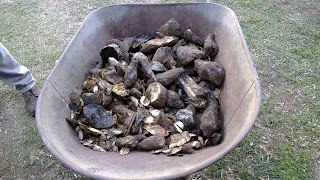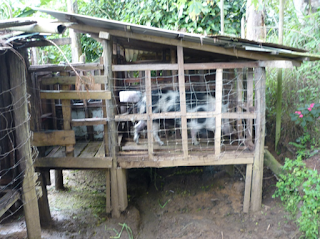10. Making silage at Farm Alstonia
This post looks further at how we made and stored the kau kau and cassava silage during our trials at Farm Alstonia Port Moresby.
 |
| There was substantial wastage from mould in the Kau Kau we bought in the Gordons' market |
Our cropping focus was on kau kau (more normally known elsewhere as sweet potato) because that was
what villagers grew in highlands.
The land at Farm Alstonia, about 24 kilometres from Port Moresby, was not suited to kau kau. We could grow kau kau leaves very well but there were few tubers on the plants. The fall back position was to buy kau kau from the Gordon's market in Port Moresby but when the bags of kau kau arrived on the farm via the Highland traders many of the tubers were half rotten. The staff trimmed them and, so they would fit into the mulcher chute, chopped them further. They shoveled them into the machine and it chopped the tubers into fine chips that looked a bit like wet wood shavings. For the first run of silage we lined 200 L drums with food grade plastic bags.
In this PNG village world, the job of gardening, looking after the children and the pigs and cooking fell to the women. Making silage was going to be one extra job for them. There had to be a better method than chipping the tubers by hand using bush knives, hence our attraction to the idea of the garden mulcher. And that might just attract the men - it certainly did on the farm. Their interest intensified in anything connected to a motor. When we were inspecting Farm Alstonia, John Cook was the first to see the mulcher and connected the dots. We quickly put it to good use.
The land at Farm Alstonia, about 24 kilometres from Port Moresby, was not suited to kau kau. We could grow kau kau leaves very well but there were few tubers on the plants. The fall back position was to buy kau kau from the Gordon's market in Port Moresby but when the bags of kau kau arrived on the farm via the Highland traders many of the tubers were half rotten. The staff trimmed them and, so they would fit into the mulcher chute, chopped them further. They shoveled them into the machine and it chopped the tubers into fine chips that looked a bit like wet wood shavings. For the first run of silage we lined 200 L drums with food grade plastic bags.
 |
| The kau kau was cleaned up, chopped, shoveled into the mulcher and the silage mulch was shoveled into the 200 L drums |
 |
| Fresh silage sealed up. Approximately a week old |
The 200 L drums themselves had been used by the Port Moresby Heineken brewery to ship malt from Australia. They were perfect for our purpose. Staff filled 200L plastic bags inside the drums with the chopped kau kau or cassava, threw in a couple of handfuls of salt to slow down mould growth on the top, and sealed them up with cable ties or cord. Each drum held about 150 kg of silage. We let it sit for about two weeks and opened it up to see if the pigs would eat it.
First impressions were good for both people and the pigs. Although on the top there was a thin, black discoloured layer about one millimeter thick, immediately underneath the silage was pale and untarnished. It looked perfectly preserved; a bit like Bircher muesli with a sweet, tobacco- like aroma, just like silage made from grass. The response from the young pigs was enthusiastic. When the silage was placed on a tray on the floor the six-week-old pigs inspected it cautiously to begin with then, once they realized that it smelt and tasted OK they leapt upon it and finished it up quickly. Although not part of the plan we fed some to the sows to see if they liked the
 |
| Alstonia silage 8 months old |
The drums were a good
idea. They preserved the kau kau or
cassava perfectly and allowed us to feed out in a way that the silage didn’t
deteriorate but, while there were plenty of them in Port Moresby there were
hardly any in the highlands. The next step was to explore the idea of burying
cassava silage. The plan was to dig a pit about a metre deep but after the
drought the ground was so hard, and Port Moresby so hot, that the best staff
could do was a pit about 500 mm deep and about 3 M square. Nonetheless, the pit worked well. Rats and mice digging into the pit were
always a risk, so the silage was wrapped in big synthetic tarpaulins. The pit
was opened after about 2-3 weeks and the quality of the silage the same as in
the drums. Silage for cattle and sheep is made above ground and covered in
plastic or below ground and buried.
All
these methods work, so we were on safe ground. We still need to repeat this
work in the highlands to find out how best to manage the pits because there it
is relatively wet all year round, and there is the risk that water will seep excessively into the pit. We
probably need about three or four pits so that they are each emptied over a
relatively short period of time so to preserve the quality of the fermented
product. I doubt they need to be lined with tarpaulins, but we will sort that
out in time.
 |
| The silage pit dug next to the pig house |
The pigs enthusiastically ate the batches of silage that we fed regardless of how long we had stored them. We labelled each drum and made sure we kept batches for as long as eight months to fully test them. I wanted to be sure that the villagers could harvest a crop and store it so they had enough feed right at the start for a group of ten pigs until they were sold.
The garden mulcher was
driven by a small Briggs and Stratton petrol engine. It was OK for Port Moresby where there were
plenty of petrol engine cars and hence plenty of fuel. In the highlands it was all diesel. Petrol was hard to get but no garden mulchers
came with diesel engines. An
electrically powered garden mulcher made in Port Moresby by Tristar
engineering worked very well until the rats ate the wiring. It was repaired and eventually shipped up to Tari but the little domestic generators that the villagers used weren’t strong enough to power it. There’s more to do on this.
engineering worked very well until the rats ate the wiring. It was repaired and eventually shipped up to Tari but the little domestic generators that the villagers used weren’t strong enough to power it. There’s more to do on this.
Petrol engines are cheaper than small diesel
engines, but petrol is hard to get in the highlands. Electric engines work well but relatively few
sites have power. Solar power works well too but the engines are more expensive
than petrol engines. I'm sure that this is something that Oil Search Ltd can help us with.
Silage provided
several advantages. The method has been demonstrated elsewhere in the world, so
we really didn’t have to reinvent the wheel.
It could be made with local crops (cassava and kau kau). It provided a way of storing a crop in an
environment for at least eight months and likely more, where crops normally rotted
after harvest or were consumed by pests.
It meant that villagers could access plenty of root crops grown
themselves or by others and harvest it in advance of feeding it to the
pigs. That meant the whole 16 -20 weeks
of feed required for the pigs could be stored ahead of the requirement.
Those who didn’t want to raise pigs could join in the business by
supplying feed. And they could add value and store the feed themselves as silage if it wasn’t
immediately required to feed the animals.
Because the fermentation preserved the crop its value was protected
leaving the way clear for a fair market to evolve. For the first time the
likelihood of a market for kau kau and cassava was emerging beyond the day to
day human consumption market. It was also
a significant advantage that neither the kau kau nor cassava needed to be
cooked. In East Timor, where I had worked, cassava had to be cooked to neutralize the cyanide produced by the strains of cassava grown there. In PNG the cassava varieties are low in cyanides.
Cassava has very similar nutrient content to kau kau and we expected it to perform well. Our early quick and dirty studies showed that the pigs happily ate fermented cassava. It didn’t seem to matter whether they were fed kau kau silage or cassava silage, they ate it just the same. Miriam wrote in her weekly report, “Since we ran out of kau kau silage on Thursday, we began feeding the test groups with cassava. We were a bit afraid of feeding them with cassava but to our surprise, in just five to eight minutes the cassava had vanished from the trough. They really enjoyed the new feed.”
Cassava has very similar nutrient content to kau kau and we expected it to perform well. Our early quick and dirty studies showed that the pigs happily ate fermented cassava. It didn’t seem to matter whether they were fed kau kau silage or cassava silage, they ate it just the same. Miriam wrote in her weekly report, “Since we ran out of kau kau silage on Thursday, we began feeding the test groups with cassava. We were a bit afraid of feeding them with cassava but to our surprise, in just five to eight minutes the cassava had vanished from the trough. They really enjoyed the new feed.”
Next blog: Our experiences buying and growing cassava.



Comments
Post a Comment